
Apiaceae or Umbelliferae is a family of mostly aromatic flowering plants named after the type genus Apium and commonly known as the celery, carrot or parsley family, or simply as umbellifers. It is the 16th-largest family of flowering plants, with more than 3,700 species in 434 genera including such well-known and economically important plants such as ajwain, angelica, anise, asafoetida, caraway, carrot, celery, chervil, coriander, cumin, dill, fennel, lovage, cow parsley, parsley, parsnip and sea holly, as well as silphium, a plant whose identity is unclear and which may be extinct.

Daucus carota, whose common names include wild carrot, bird's nest, bishop's lace, and Queen Anne's lace, is a white, flowering plant in the family Apiaceae, native to temperate regions of Europe and southwest Asia, and naturalized to North America and Australia.

Daucus is a worldwide genus of herbaceous plants of the celery family Apiaceae of which the best-known species is the cultivated carrot. Daucus has about 25 species. The oldest carrot fossil is 1.3 Ma, and was found in Madeira island
Bishop's weed is a common name for several plants, all but one of which belong to the plant family Apiaceae.
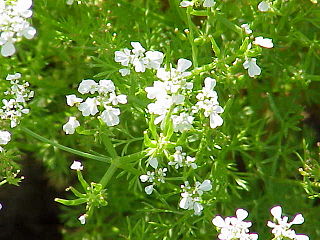
Anthriscus (chervils) is a common plant genus of the family Apiaceae, growing in Europe and temperate parts of Asia. It comprises 15 species. The genus grows in meadows and verges on slightly wet porous soils. One species, Anthriscus cerefolium is cultivated and used in the kitchen to flavor foods.
White carrot may refer to:
In botany, an umbel is an inflorescence that consists of a number of short flower stalks which spread from a common point, somewhat like umbrella ribs. The word was coined in botanical usage in the 1590s, from Latin umbella "parasol, sunshade". The arrangement can vary from being flat-topped to almost spherical. Umbels can be simple or compound. The secondary umbels of compound umbels are known as umbellules or umbellets. A small umbel is called an umbellule. The arrangement of the inflorescence in umbels is referred to as umbellate, or occasionally subumbellate.
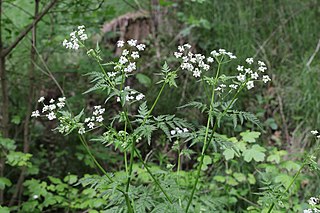
Anthriscus sylvestris, known as cow parsley, wild chervil, wild beaked parsley, Queen Anne's lace or keck, is a herbaceous biennial or short-lived perennial plant in the family Apiaceae (Umbelliferae), genus Anthriscus. It is also sometimes called mother-die, a name that is also applied to the common hawthorn. It is native to Europe, western Asia and northwestern Africa; in the south of its range in the Mediterranean region, it is limited to higher altitudes. It is related to other diverse members of Apiaceae, such as parsley, carrot, hemlock and hogweed. It is often confused with Daucus carota which is also known as Queen Anne's lace or wild carrot, also a member of the Apiaceae.
Laceflower is a common name for several plants and may refer to:

Ammi visnaga is a species of flowering plant in the carrot family known by many common names, including toothpick-plant, toothpickweed, bisnaga, khella, or sometimes Bishop's weed. It is native to Europe, Asia, and North Africa, but it can be found throughout the world as an introduced species. This is an erect annual plant growing from a taproot to a maximum height near 80 centimeters. The leaves are up to 20 centimeters long and generally oval to triangular in shape but dissected into many small linear to lance-shaped segments. The inflorescence is a compound umbel of white flowers similar to those of other Apiaceae species. The fruit is a compressed oval-shaped body less than 3 millimeters long. This and other Ammi species are sources of khellin, a diuretic extract.

Euleia heraclei, known as the celery fly or the hogweed picture-wing fly is a species of tephritid or fruit flies in the genus Euleia of the family Tephritidae.
A. sylvestris may refer to:
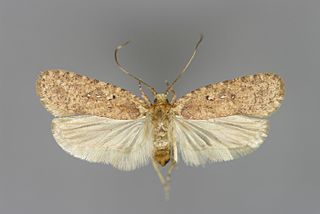
Agonopterix heracliana is a moth of the family Depressariidae. It is found in most of Europe, North Africa, the Near East, and the eastern part of the Palearctic realm.
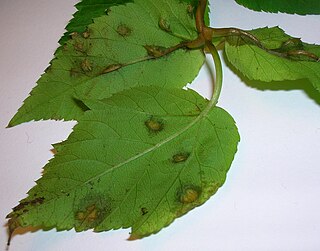
Protomyces macrosporus is an ascomycete fungus that forms galls on Aegopodium podagraria, Anthriscus sylvestris, Angelica sylvestris, Daucus carota and some other members of the family Umbelliferae or Apiaceae, commonly known as umbellifers. Fourteen genera within the Asteraceae are also galled by P. macrosporus. The description of the genus was based on Protomyces macrosporus as the type genus for the family Protomycetaceae.

Agonopterix purpurea is a moth of the family Depressariidae. It is found in most of Europe.

Epermenia chaerophyllella, also known as the garden lance-wing, is a moth of the family Epermeniidae first described by Johann August Ephraim Goeze in 1783. It is found in all of Europe and Asia Minor.
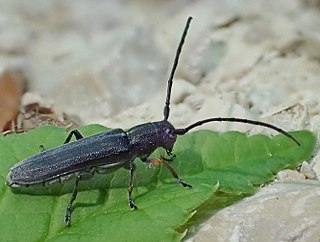
Phytoecia cylindrica is a species of beetle in the family Cerambycidae. It was described by Carl Linnaeus in 1758. It has a wide distribution throughout Europe. It feeds on Daucus carota, Laserpitium siler, Astrantia major, Anthriscus sylvestris, Heracleum sphondylium. It measures between 6 to 12 mm.

Liparus coronatus is a species of beetles belonging to the family Curculionidae.

Pammene gallicana is a moth belonging to the family Tortricidae first described by Achille Guenée in 1845.
















